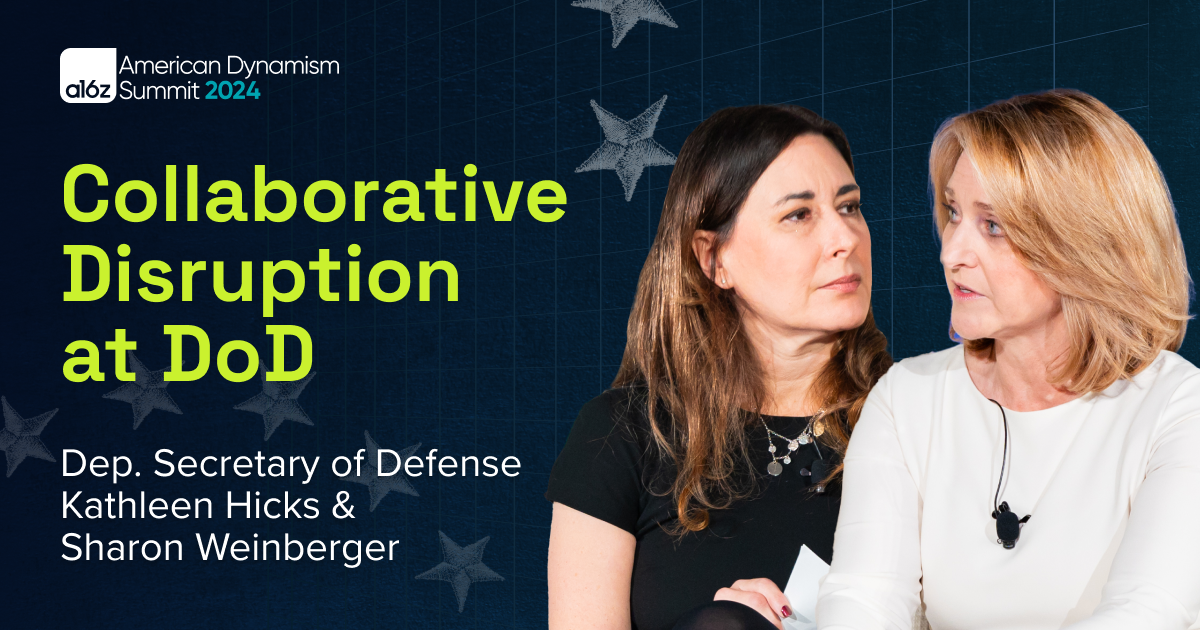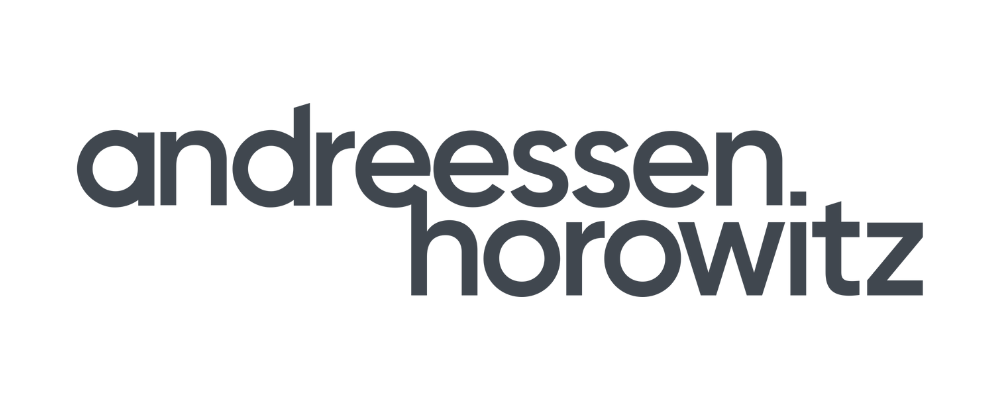At January’s American Dynamism Summit, U.S. Deputy Secretary of Defense Kathleen Hicks discussed the Department of Defense’s renewed commitment to innovation and the department’s new Replicator initiative, which is accelerating how the DoD procures and delivers capabilities to the warfighter at speed and scale. (Read her full remarks here.)
Following her keynote remarks, Dep. Sec. Hicks sat down for an interview with Wall Street Journal national security and foreign policy editor Sharon Weinberger. Here is a transcript of their conversation:
Sharon Weinberger: I wanted to start off with a more somber note of what you referenced in your speech talking about the tragic loss of life of the three U.S. service members. Is that, I realize it’s still early days in terms of what happened, but counter-UAS, counter-drone systems have been a big topic. It’s an area where a lot of companies are trying to innovate. Is this an area where there are lessons to be learned from that and ways to accelerate technologies to the battlefield?
Kathleen Hicks: Absolutely. First of all, I think it’s about our 165th attack on us using those sorts of techniques, largely UAS, but a variety of techniques. This one hit, it took three U.S. service members and wounded many more. And that is absolutely unacceptable to the United States. And, you know, that’s an issue that is being worked very closely, as I’m sure those watching the news have seen, by the President. It is an area we have been very focused on, counter-UAS. And, yes, we absolutely know we need to continue to evolve there.
So, software-driven Ukraine more than anywhere else has shown the rapid pace of iteration in terms of the development of the technologies and the capabilities. Again, a lot of it is software, there are some other aspects. Without the budget, it’s very, very hard for us. There are great limitations on what we can do under a continuing resolution. We have some rapid acquisition authorities. We are using everything we have. But there are, just frankly, limits to not having the government functioning as it should, and we need that 2024 budget.
Sharon: On Replicator, which you both acknowledge, there’s a lot of excitement and also questions about it. It sounds like you’re committed to the August 2025 timeline for it. What is the metric for success? When you get to that point, what are the concerns? What are the things that would say, “That didn’t quite work out as we planned or that worked out great?” How do you measure that?
Kathleen: I think there are a couple of different measures. The first is, did we meet that goal across multiple domains in the thousands in the timeline, 18 to 24 months? We know it’s an audacious goal. We set it at the beginning. I’m confident we’re doing everything on track to get there. We’re going meet that goal. But the real payoff, even though that’s real payoff to the warfighter. If you talk to the INDOPACOM team, they’re very excited by what we hope to deliver. The real payoff is, you know, not trying to hack the system in one particular way but to transform the system at DOD.
Replicator, as I said, is the latest of our efforts. It actually quite very clearly, for those who are kind of following the game, building on work we’ve done in Raider and CAP, sorry to throw up more acronyms. But very clearly driving down the risk, burning down risk for our processes inside the building, trying to identify where we are in our own way, or maybe where there’s some frozen middle issues that get stuck. So, another aspect of success beyond the immediate is, are we able to then take this, bring it into other areas, and transform the system to speed it up?
Sharon: Another thing you talked about is just this tremendous amount of private investment venture capital going into defense. We recently wrote about the 100 billion that’s gone in since 2021. But one of the concerns from those companies and from those investors is that it’s not being matched yet by acquisition dollars. Is that a concern for you? And how do we actually change that?
Kathleen: Yeah, so first of all, I think that, I really would hit that our procurement budget request for ’24 is, you know, the highest set in peacetime, you know, era or second highest in the peacetime era in 35 years. So, it’s not that we don’t have money going into acquisition. The question is, what are we acquiring? Are we acquiring what the warfighter needs and are we acquiring everything we think the warfighter needs? Well, we’ve always had to make hard choices. So, there’s no surprise that we will continue to have to make trade-offs.
I think what I would stress is, as we innovate and move through the changing nature of warfare, again, shaping that changing nature of warfare, we know so much of what is in that shift is software-defined, and also could be manufactured much more rapidly through advanced manufacturing. There are a lot of areas, biotech, I could think of others, that are driven right now by the commercial sector. So, as we shift in the nature of warfare, there’s more and more opportunity for non-traditionals and service providers to be a part of that procurement story. So, lots of dollars go into procurement, that’s not the issue. The issue is, are we able to buy what we need and are we thinking far enough ahead to what the shape of warfare needs to be?
Sharon: So, what, in that view, does the defense industrial base look like in, you know, we could say five years, 10 years time, are there more than five primes? Are there a dozen primes? How does that actually look in terms of a successful change in strategy?
Kathleen: I don’t think there’s a pre-definition of number of primes. I think it is important to have competition in the defense industrial base. There’s no doubt about it. And we know small business is a huge driver of that. Pardon me. So we work very hard on trying to drive up the percent of our procurement and investment that is going to those small businesses. With apologies. But I don’t think I would try to guess here today how many primes there would be. I think the whole nature of what constitutes the defense industrial base, we need to shift that mental model.
The American industrial base is the defense industrial base. We obviously have traditional providers we greatly value. We need them. We need them to stay at the cutting edge and we continue to work hard with them. But, you know, it’s very clear to everyone, including them, that teaming with other parts of the economy, understanding the new areas of innovation, compute, others, is incredibly vital to growing where we need to go in defense.
Sharon: You talked about this long history of cooperation that goes back decades between Silicon Valley and the Pentagon. There have also been periods where there’s been a rift, most notably after the Vietnam War period, and then there was a big effort to heal that rift. We’ve clearly come a long way. Are there still issues there? Is there still a need to overcome some of the hesitancy of tech Silicon Valley to work with the Pentagon or do you feel like we’re pretty much where we need to be?
Kathleen: I think that’s a constant refrain for us. And we focus very much on as a department across administrations, you know, I think there has been a strong focus on making sure that companies wanna work with us. We know part of that is making sure we represent the values of the nation. And we lean forward on that. That’s always been important for the United States in terms of bringing the commercial sector in to work with government. So we continue to do that today. I don’t think we are in a crisis phase, to use your Vietnam analogy. And I do think, as I said in my remarks, that the PRC did a lot of that work by comparison. And the types of both their military activities and the types of coercive strategies they use working with companies have done a lot to turn others to looking to how you can work with us.
I will stress one area that we’ve been very clear about is our responsible AI approach and a responsible autonomy approach. That’s decades-long, but we continue to evolve it as the technology evolves. We have Project Lima right now, which is looking at large language models. Safety is vital to effectiveness for us. These aren’t trade-offs, they’re one and the same. So, we look at how to adopt innovations in a way that’s safe for our warfighters and, again, reflective of American values. And we’ll continue to do that.
Sharon: You actually preempted my next question, which is on Lima, on that task force, looking at generative AI, where is it at? What do you see coming out of that? What are the issues it’s looking at, if you could expand on that?
Kathleen: Sure. So they are looking at hundreds of use cases to identify, what’s the right framework for the department? This spring is when that information comes forward to the CDAO and then to me and the Secretary thereafter. So, I anticipate getting some feedback on where there are use cases that are ready to go today if there are those, and the other areas where we need to do more work. But we work closely with all the major generative AI, you know, providers and would-be providers to make sure we’re lashed up. We’re very enthusiastic to work with them. We just have to do it in a way that actually delivers for the warfighter.
Sharon: You spoke about both Ukraine and then the challenge from China. There have been a lot of new technologies deployed in Ukraine. In some ways, it’s been almost, I think some people have compared it to a test lab for things like UAVs, for drones. What are some of the lessons learned out of that from your perspective of the technologies that have been deployed there?
Kathleen: Sure. I think what I would stress for the U.S. really has been the proliferation of space, low Earth orbit satellites, in particular, and communications, that the commercial sector really drove. That’s been a clear, that ability to communicate and have masts that’s distributed has paid off. I think when you look at autonomy, it’s a more mixed picture in terms of exactly how it has evolved, where it has provided benefit. And we take all of those lessons away. I think one piece that the United States has an advantage on over other competitors is that when innovation happens down at the unit level, we know how to bring that up and scale it.
We also need to make sure we do that exceptionally well and fast, so, that tactical innovations, TTP innovations that happen, software innovations that some very clever sergeant comes up with, for instance, which you see in Ukraine all the time, that sort of is lifted up and promulgated quickly across the force as we go through rapid iteration. So I think that’s another lesson I would add. And then the last is Intel, in general. The United States clearly has an advantage in intelligence that’s paid off substantially, and to the extent that we can help our partners with that, in this case, Ukraine, you know, that’s an area we know is a strength to build on.
Sharon: That iterative process that you talked about, particularly coming down from the tactical level, how do you get that into the U.S. system?
Kathleen: It’s an all hands on deck. It comes at all kinds of different levels. We’ve really emphasized with the warfighting concept, making sure that there’s rapid concept to experimentation to fielding. That’s our radar initiative, excuse me, is one of those areas where we’ve really tried to highlight, how do you quickly take a concept, make sure you have the right testing environment, experimentation environment, the lab, if you will, the substitute for Ukraine, for us, the experiment and exercise realm for us out with our co-coms. And you see a lot of that innovation going on today, SOUTHCOM, CENTCOM, INDOPACOM. Others are doing a lot of that work.
That’s how we do it. Really make sure we’re testing it in the field with the warfighter, closely linked to the technologist, so the operator and the technologist work together to do that rapid iteration. A lot of this too is, again, concept of employment. So, it’s not just technology. It’s about, how do we use that technology best? And that’s where we really can excel. We have the most incredible military service members. They are individuals who are incented to bring forward their best. That is definitely a different model than authoritarian states.
Sharon: It feels like still sort of the biggest barrier. You talked about, you know, American ingenuity is where we have an advantage over China. It still very much feels like our acquisition process is the 300-pound gorilla. Can we get to where we need to be without fundamentally reforming Defense Department acquisition?
Kathleen: I think we have to fundamentally reform defense acquisition. But we are down that path. We did have the alternative acquisition pathways, middle tier acquisition pathways, for example. We have to prove those out. We have to show that those pathways, software is one, for example, we’ve already put billions of dollars through that software acquisition pathway. Now we have to show our oversight committees that we can deliver through those alternate pathways because there is a different oversight model built into those. And it’s really about trust between Congress and the executive branch to prove out that we can do good things with these tools that they’ve given us.
So that’s why we’ve been so focused in this administration on taking all those authority changes, showing we can advance against them. Replicator is an example of that. And then, where we can, build that trust, I think there’s more opportunity to expand our authority. So, yes, we need acquisition reform. We’re in acquisition reform now. And we need to build trust as we go through that.
Sharon: Turn it back to Replicator for a moment, since you mentioned it. So, there have been specific capabilities that have been selected. When do you think we’ll learn about specific systems?
Kathleen: So the systems we are talking to Congress about in the immediate, so, we’re having those conversations right now, at the system level, expect to have those… And we’ve been working with… Sorry, let me step back and say, we’ve been already working with Congress, they know what’s coming. The system-level information comes forward in the next several days, as I said in my remarks. When you’ll know about them at the system level is a different issue.
We have a classification guidance we’re working through. It is not unusual for the Defense Department to keep some aspects of the systems that we are pursuing at a classified level. It doesn’t mean that we are hiding them. And we worked very closely with Congress. There’s nothing hidden from Congress. They have to approve all of that funding. So, we’ll work closely with them and more to follow in terms of what we’ll share publicly.
Sharon: Right. Are you surprised where we are now with tech in Silicon Valley compared to five years ago?
Kathleen: I am. I think it is a marker for what’s happened, I think, in broader world events. I think there’s more ability to see how you as an individual innovator or investor can contribute, you know, to the American experience, to American dynamism, dare I say, and more concern about what the alternative might hold. We’ve seen that in Hong Kong, we’ve seen that elsewhere. And I think that, more than anything, has brought to mind what the risks are for falling behind.
Sharon: It’s a great way to wrap up. Thank you so much.
Kathleen: Thank you. All right, thanks.
“Andreessen Horowitz is a private American venture capital firm, founded in 2009 by Marc Andreessen and Ben Horowitz. The company is headquartered in Menlo Park, California. As of April 2023, Andreessen Horowitz ranks first on the list of venture capital firms by AUM.”
Please visit the firm link to site






